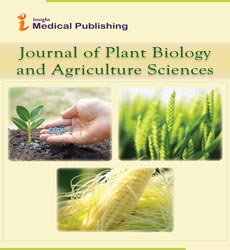A Significant Drawback to Vegetative Multiplication
Hyunglok Kim*
The Department of Engineering Systems and Environment, University of Virginia, Charlottesville,VA 22904, USA
- *Corresponding Author:
- Hyunglok Kim
The Department of Engineering Systems and Environment, University of Virginia, Charlottesville,VA 22904, USA
E-mail: hk5kp@virginia.edu
Received date: 05 August, 2021; Accepted date: 16 August, 2021; Published date: 23 August, 2021.
Citation:Dr. Hyunglok K (2021) A Significant Drawback to VegetativeMultiplication.J Plant Bio Agric Sci Vol.5 No.6:e002
Introduction
Plant propagationis the creationof new posterity in plants,which can be refinedby sexual or agamic generation.Sexualproliferation produces posterity by the combination of gametes,bringing about posterity hereditarily unique in relationto theparent or guardians. Agamic generationcreates new peoplewithout the combinationof gametes, hereditarilyindistinguishable from the parent plants and one another, asidefrom when transformationshappen. Agamic generationdoesn'tinclude the creationand combinationof male and femalegametes. Agamic multiplicationmight happen through parallelFission, maturing, fracture, spore development, recovery andvegetativeengendering. Plants have two primary kinds ofagamic generationin which new plants are delivered that arehereditarily indistinguishableclones of the parent person.Vegetativepropagationincludes a vegetativepiece of the firstplant (sprouting,tillering,and so forth) and is recognized fromapomixis, which is a substitutionof sexual generation,andsometimesincludes seeds. Apomixis happens in many plantspecies and furthermore in some non-plant organic entities. Forapomixis and comparativecycles in non-plant living beings, seeparthenogenesis. Normal vegetativegeneration is an interactionfor the most part found in herbaceous and woody enduringplants, and regularly includes underlying adjustments of thestem or establishes and in a couple of animal groups leaves.Most plant species that utilizevegetativeproliferationdo assuch as a way to perennialize the plants, permitting them to getby startingwith one season then onto the next and frequentlyworking with their development in size. A plant that endures inan area through vegetativeproliferation of people establishes aclonal state; a solitary ramet, or obvious individual, of a clonalsettlementis hereditarily indistinguishablefrom all others in asimilar province. The distance that a plant can move duringvegetativemultiplication is restricted, however a few plants candeliver ramets from stretching rhizomes or stolons that cover awide region, regularly in a couple of developing seasons. As itwere, this interactionisn't one of proliferationyet one ofendurance and extension of biomass of the person. At the pointwhen an individual organic entity expansions in size by means ofcell duplicationand stays unblemished, the cycle is calledvegetative development. Nonetheless, in vegetativegeneration,the new plants that outcome are new people in prettymuchevery regard aside from hereditary. A significantdrawback tovegetativemultiplication,is the transmission of microorganismsfrom parent to posterity; it is exceptional for microbes to be sentfrom the plant to its seeds (in sexual propagationor inapomixis), however there are events when it occurs.Seedsproduced by apomixis are a method for agamic proliferation,including the arrangement and dispersal of seeds that don'tbegin from the preparationof the incipient organisms.Hawkweed (Hieracium), dandelion (Taraxacum), some (Citrus)and Kentucky country (Poa pratensis) all utilizationthis type ofabiogeneticmultiplication.Pseudogamy happens in certainplants that have apomicticseeds, where fertilizationisfrequently expected to start undeveloped organismdevelopment, however the dust contributes no hereditarymaterial to the creatingoffspring.Other types of apomixishappen in plants likewise, remembering the age of a plantlet forsubstitution of a seed or the age of bulbils rather than blossoms,where new cloned people are delivered. Agamic multiplication isa sort of generation where the posterity comes from one parentjust, consequently, acquiring the attributesof the parent.Unusual buds structure on roots close to the ground surface, onharmed stems (as on the stumps of cut trees), or on old roots.These form into over the ground stems and leaves. A type ofmaturing called suckering is the multiplicationor recovery of aplant by shoots that emerge from a current root framework.Species that typically produce suckers incorporate Elm (Ulmus),Dandelion (Taraxacum), and numerous individuals from the Rosefamily like Rosa and Rubus.
Open Access Journals
- Aquaculture & Veterinary Science
- Chemistry & Chemical Sciences
- Clinical Sciences
- Engineering
- General Science
- Genetics & Molecular Biology
- Health Care & Nursing
- Immunology & Microbiology
- Materials Science
- Mathematics & Physics
- Medical Sciences
- Neurology & Psychiatry
- Oncology & Cancer Science
- Pharmaceutical Sciences
